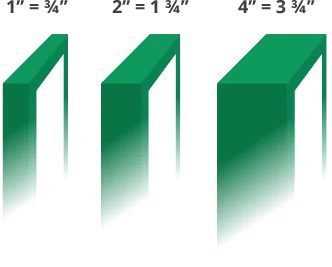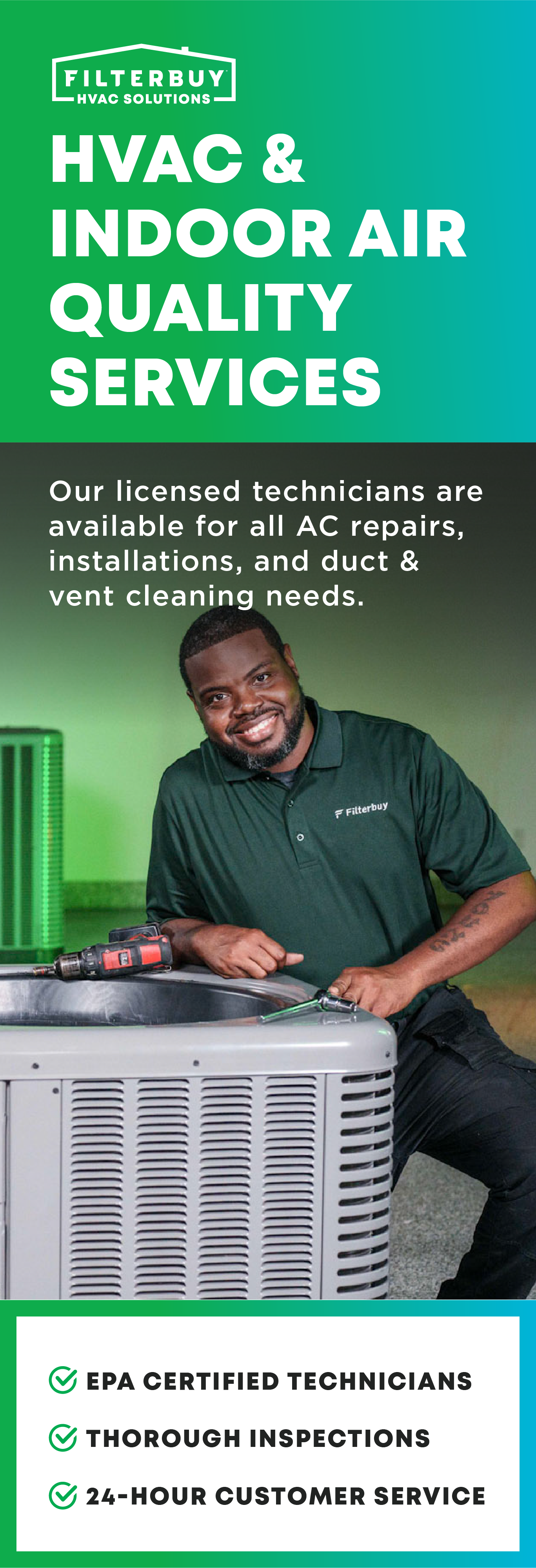In the U.S. roughly 84% of homes have some sort of air conditioning or heating system. The vast majority use a central air and heat system known as an HVAC (Heating, Ventilation, and Air Conditioning) system to regulate the temperature inside the home. An HVAC system is made up of large pieces of machinery as well as smaller components. They all work together to heat and cool the home by continuously circulating conditioned air throughout the house. Each part is important, including the air filter.
Home air filters not only protect the rest of the HVAC system, but they can also protect your family’s health by purifying the air of pathogens, allergens and a number of other contaminants.
Core Components of An Air Filtration System
Before we answer the question of “how air filters work,” it helps to go over the core components of an air filtration system, so you understand how the filters fit in. There are five core components to know:
- Intake Vent - This is where the AC unit pulls air from inside your home into the unit.
- Air Ducts - Ducts are insulated piping that runs through the ceiling and walls to distribute conditioned air around the home.
- Vents - The air ducts are connected to vents in the walls that allow conditioned air into living spaces.
- Portable Room Air Purifiers - These standalone devices purify a limited space by drawing air into the purifier, trapping contaminants in a filter, and expelling the purified air back out into the room.
- Air Filters - An air filter is a screen within the HVAC system. It’s strategically located so that all air coming into the HVAC system passes through the filter first so that contaminants can be trapped and removed from the air.

How Your Home Air Filters Work
One of the most vital components of your air filtration system is the home air filter. Home air filters are amazingly simple for what they are able to do.
Home air filtration is needed because the air circulating in a home typically contains contaminants. If left unattended, these particles will continue to circulate unless they are physically removed from the air.
Air filters are the center of a home air filtration system. They are the sole component that ensures the air circulating in your house is clean and safe.
Below is a step-by-step rundown of what happens as the air filter works to purify the air inside your home.
Step 1: Start with a Clean Air Filter Installed in the HVAC System
This step isn’t something that your HVAC system does on its own, but without a clean air filter, you won’t be able to filter out the unwanted particles in the air. Make sure that you find an air filter that is the proper size for your AC system.


Step 2: The HVAC System Turns on and Starts Pushing Air Through the House
There are multiple ways to engage your HVAC system. For modern air systems, air begins circulating once you change the ambient temperature settings in your house. You can also simply turn on your HVAC fan to circulate air throughout the house without “conditioning” it.
Step 3: As Air is Pushed Out, the HVAC System Also Pulls Air in Through the Intake Vents
While air is pushed through your room vents, air is also pulled in through your intake vents. In most cases, there are two large vents located near the HVAC system in the house that handle the intake. By now, you should be familiar with where those are in your house and what size filter goes in them.


Step 4: As Air Goes Through Your Intake Vents, it is Forced Through Your Air Filter
Assuming you have a clean air filter in place, it creates a barrier between your circulated air and filtered air going into your HVAC system.
Step 5: As Air Passes Through the Filter Media, Small Particles Get Trapped and Stay Behind
Depending on the filter rating, particles are trapped in your filter screen, or filter media. For certain types of filters—like carbon filters—the filter will also disinfect the air and neutralize unwanted bacteria.


Step 6: Clean Air Continues to the Main AC Manifold to be Pushed Throughout the Home
The air, now cleaned, moves along to the main manifold to be circulated throughout the house. Then, the process starts all over again.
As long as the air filter isn’t fully saturated it will continuously trap air particles when the HVAC system is running.
Different Types of Filters for the Home
For different air filtration systems, there are different air filters that have slightly different methods of how they clean the air. Below are the 4 primary types of whole house air filters:

Traditional Fiberglass Air Filters
These are the traditional type of filter for residential HVAC systems. If you have a furnace, then your system uses flat filters. Flat filters are usually fiberglass or pleated. The pleated type of air furnace is the superior option for air filtration. MERV rating is used to signify the efficiency of the air filter. No special installation is needed for flat filters, but it is important to make sure you use the proper size for the compartment.

Electronic Filters
Even air filters have gone digital. Electronic filters, also sometimes called electrostatic precipitators, are fitted within the ducts to electrically charged particles as they pass through the filter. The charged particles are then captured by an oppositely charged collection plate.

Ultraviolet Filters
This type of filter is built within the HVAC system to kill bacteria, viruses and germs with UV light. Usually, the ultraviolet filter is an add-on that’s connected to an electrostatic precipitator.

Extended Media Filters
Extended media filters basically stack on top of one another to create an extra thick filter. However, to use extended media filters a large filter compartment will need to be fitted into the ductwork.
Room Air Purifiers vs. Whole Home Air Filters
A common misconception is that room air purifiers are the same as whole house air filters or that they’re interchangeable. In actuality, they are distinctly different and ideally can be used together for optimal air purification.
Whole home air filters are designed to be used within the HVAC system to purify air throughout the entire house. They are able to do this because all of the air circulated through the HVAC passes through the air filter. Room air purifiers don’t work on as large a scale. They are limited to a certain amount of space directly around the air purifier.

However, the upside is that room air purifiers can be used with a HEPA filter (more on that below).
In terms of improving air quality, a high-quality whole home air filter is your best bet since it treats all the air in circulation. You can even incorporate filter add-ons like an electrostatic precipitator to increase the purification.
A room air purifier is a good addition in places where extra purification is needed. For instance, if someone in the home has allergies, it’s a good idea to use a purifier in their bedroom.
Can You Use a HEPA Filter for the Whole House?
Generally, HEPA filters aren’t used for whole house filtration. It’s not a matter of how well they clean the air but what they can do to the HVAC system.
High efficiency particulate air (HEPA) filters have a minimum efficiency of 99.97% at 0.3 microns. That means they are better at capturing a wider array of air particles than filters with a high MERV rating.
But here’s the downside. HEPA filters significantly restrict the air flow within the HVAC system. The strain on the system can reduce efficiency, increase energy use, and cause premature wear on the HVAC components. That’s why HEPA air filters are usually only used in commercial HVAC systems at hospitals and laboratories.
However, there is a place for HEPA air filters in a whole home air filtration system. If you choose to use a room air purifier, choose one with a true HEPA filter for extra purification.
Signs It’s Time to Change Your Home Air Filter
How often do you really need to change an HVAC filter? And how will you know when it’s time to replace an air filter?
In general home air filters should be replaced at least once every three months. But if you are concerned about allergens and pathogens, you have indoor pets, or someone in the home smokes, you’ll want to change it more frequently. Using a low-quality air filter can also increase how often you need to replace your filters.

Beyond those guidelines, there are a few signs to watch out for that signal it’s time to change your home air filter. Common signs that it’s time to change your whole home air filter include:
- Dust around your vents
- Noticeable decrease in the air quality
- HVAC system not running as efficiently (check your utility bill to see if there’s been an increase in electricity usage)
- The air conditioning unit is running hot
- Increase in allergy attacks
- You can’t remember the last time you changed the air filter
When your air filter can no longer do its job, use this step-by-step guide for replacing your air filter if you’ve never done it before.
How Air Filters Work FAQs
How much does a good air filter improve air quality?
That largely depends on the air quality in general and the air filter you choose. But no matter what filter is used you should notice an improvement compared to using no filter at all.
Can air filters prevent the spread of airborne illness (like COVID-19)?
Yes, air filters with higher MERV ratings and HEPA filters are able to remove viral particles from the air.
How does dust get through my air filter in my AC unit?
There are two common reasons why dust gets past an air filter and into the AC unit. The first reason is poor fit. If the filter doesn’t sit perfectly in the compartment, there will be air gaps that allow debris through. The second reason is a dirty air filter that can no longer hold any more particles.
What happens if I don’t put an air filter in my AC unit?
Without an air filter, contaminants in the air can get into the AC unit components and cause major damage. Read this article for more information on running your AC without a filter.
Shop the Most Popular Sized Air Filters
Below, you can select form our most popular sizes of home air filters.

.webp)
.webp)
.webp)
.webp)




 20 x 20 x 1
20 x 20 x 1 


